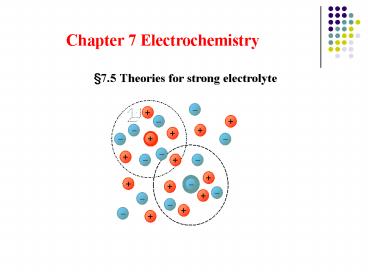Chapter 7 Electrochemistry - PowerPoint PPT Presentation
1 / 12
Title: Chapter 7 Electrochemistry
1
Chapter 7 Electrochemistry
7.5 Theories for strong electrolyte
2
Self reading Ira N. Levine, Physical
Chemistry, 5th Ed., McGraw-Hill, 2002. pp.
300-304 Section 10.8 the Debye-Hückel theory of
electrolyte solutions
3
Empirical formula for electrolyte solution
Stationary property
Dynamic property
For ideal solution
For nonideal solution
Theoretical evaluation of Wr Before 1894
treated solution as ideal gas 1918-1920 Ghosh
crystal structure 1923 Debye-Hückel ionic
atmosphere
4
1. The Debye-Hückel theory
Ionic atmosphere Radius1100 nm
Basic assumptions 1) Point charge 2) Only
coulombic attraction 3) Dielectric constant
keep unchanged 4) Boltzmann distribution,
Poisson equation
Peter J. W. Debye 1936 Noble Prize Germany,
Netherlands 1884/03/24 1966/11/02 Studies on
dipole moments and the diffraction of X rays
5
Shielded Coulombic potential
Debye length
6
Group exercise
Deduce
Lewiss empirical equation
from
7
for aqueous solution at 298 K
8
Debye-Hückel limiting law holds quite well
for dilute solutions (Ilt 0.01 m), but must be
modified to account for the drastic deviations
that occur at high concentrations.
Valid for c lt 0.1 molkg-1
Valid for c lt 1 molkg-1
9
2. Debye-Hückel-Onsage theory
In 1927, Lars Onsager pointed out that as the
ion moves across the solution, its ionic
atmosphere is repeatedly
being destroyed and formed again. The time for
formation of a new ionic atmosphere (relaxation
time) is ca. 10-7 s in an 0.01 molkg-1
solution. Under normal conditions, the velocity
of an ion is sufficiently slow so that the
electrostatic force exerted by the atmosphere on
the ion tends to retard its motion and hence to
decrease the conductance.
1) Relaxation effect 2) Electrophoretic effect
10
Valid for 3?10-5 10-3 molkg-1 Fuoss valid for
lt 0.1 molkg-1 Falkenhagen valid for lt 5
molkg-1, for LiCl valid until 9 molkg-1
Lars Onsager 1968 Noble Prize USA,
Norway 1903/11/271976/10/05 Studies on the
thermodynamics of irreversible processes
11
Progress of the theories for electrolyte
1800 Nicholson and Carlisle electrolysis of
water 1805 Grotthuss orientation of
molecules 1857 Clausius embryo of
dissociation 1886 vant Hoff colligative
property 1887 Arrhenius dissociation and
ionization 1918 Ghosh crystalline
structure 1923 Debye-Hückel Debye-Hückel
theory 1926 Bjerrum conjugation theory 1927
Onsager Debye-Hückel-Onsager theory 1948
Robinson and Stokes solvation theory
12
Question Compare the solubility of AgCl(s)
in NaCl solution, pure water, and concentrated
KNO3 solution using that in pure water as
standard.
AgCl(s) Ag(aq) Cl(aq)
Solubility equilibrium and the effect of co-ion.
ionic strength on solubility salt effect































